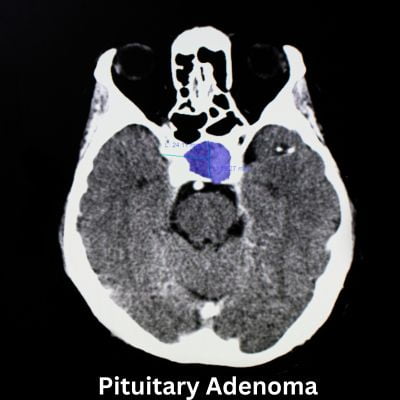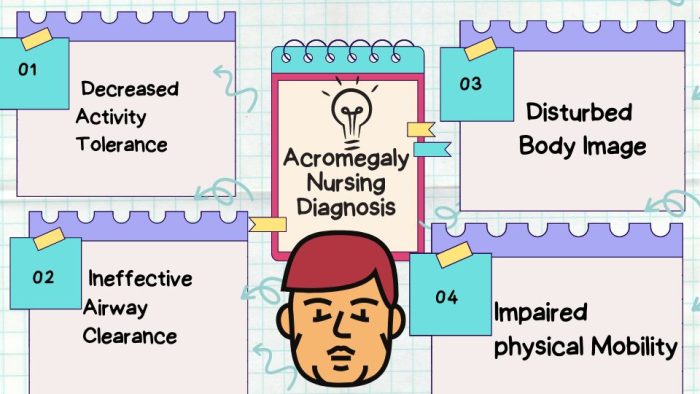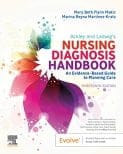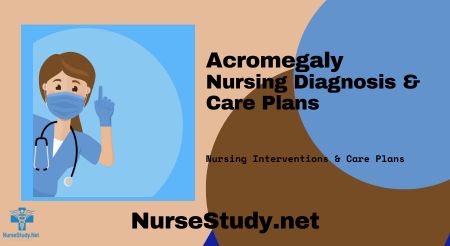Last updated on January 27th, 2024 at 09:39 am
Acromegaly is a rare disease that affects the pituitary gland, causing it to produce too much growth hormone. This excessive growth hormone can lead to a variety of symptoms, including enlarged hands and feet.
While there is no cure for acromegaly, there are treatments available to manage the symptoms and slow the progression of the disease. Nursing diagnosis for Acromegaly is essential for the patients plan of care.
Acromegaly
Definition
Acromegaly is a rare hormonal disorder that occurs when the pituitary gland produces too much growth hormone (GH). This excess GH causes the body’s tissues and bones to grow and enlarge, leading to various physical changes and medical complications.
Causes
The most common cause of acromegaly is a benign tumor in the pituitary gland also called pituitary adenomas that secretes excess growth hormone GH. This growth hormone excess in rare cases can cause tumors in other parts of the body, such as the lungs or pancreas.
Symptoms
The symptoms of acromegaly develop slowly over time and can vary widely from person to person. Some common symptoms include enlarged hands and feet, thickened skin, a deepening of the voice, and an enlarged jaw.
Other symptoms may include arthritis, high blood pressure, cardiovascular disease, soft tissue swelling, weakness, galactorrhea, erectile dysfunction, and hypertension.
Complications
If left untreated, acromegaly can lead to several medical complications, including cardiomyopathy, skin tags, joint problems, and hypothyroidism. Additionally, people with acromegaly have an increased risk of developing diabetes and certain types of cancer such as ovarian cancers.
Diagnosis
Acromegaly is a rare disease that can be difficult to diagnose. The diagnosis of acromegaly is based on clinical symptoms and laboratory tests. The clinical symptoms of acromegaly are caused by the excess production of growth hormone (GH) and insulin-like growth factor 1 (IGF-1) by the pituitary gland. The diagnosis of acromegaly is confirmed by laboratory tests that show elevated levels of GH and IGF-1.

Blood Tests
Blood tests are the first step in diagnosing acromegaly. The most important blood test is the measurement of GH and IGF-1 levels. Elevated levels of GH and IGF-1 are suggestive of acromegaly. However, elevated GH levels alone are not sufficient to make a diagnosis of acromegaly, as GH levels can fluctuate throughout the day and can be affected by stress and exercise.
Glucose Tolerance Test
A glucose tolerance test (GTT) is a test that measures the body’s ability to handle glucose. A GTT is used to diagnose acromegaly because people with acromegaly have impaired glucose tolerance due to the excess production of GH. During a GTT, the patient is given a glucose drink, and blood samples are taken at regular intervals to measure glucose and insulin levels.
CT Scan
A CT scan is a type of X-ray that uses a computer to create detailed images of the body. A CT scan can be used to look for abnormalities in the pituitary gland, which can indicate acromegaly. However, a CT scan is not always able to detect small tumors in the pituitary gland.
MRI Scan
An MRI scan is a type of imaging test that uses a magnetic field and radio waves to create detailed images of the body. An MRI scan is more sensitive than a CT scan and can detect smaller tumors in the pituitary gland. An MRI scan is often used to confirm the diagnosis of acromegaly.
Imaging Tests
Imaging tests, such as a CT scan or an MRI scan, are often used to look for tumors in the pituitary gland. However, not all people with acromegaly have tumors in the pituitary gland. In some cases, tumors can be located in other parts of the body, such as the pancreas or the lungs. Imaging tests can also be used to monitor the growth of tumors and the effectiveness of treatment.
Treatment
Acromegaly can be treated with a combination of surgery, medication, and radiation therapy. The choice of treatment depends on the severity of the condition, the size and location of the tumor, and the age and overall health of the patient.
Surgery
Transsphenoidal surgery is the most common treatment for acromegaly. This procedure involves surgery surgical removal of the tumor through the nose or mouth, without making any incisions on the face. The success rate of this surgery is high, and it can lead to a significant reduction in growth hormone levels.
Medication
Several medications are available to treat acromegaly, including somatostatin analogs, dopamine agonists, and growth hormone receptor antagonists.
Somatostatin Analogs
Octreotide and lanreotide are somatostatin analogs that can be used to reduce growth hormone levels in acromegaly patients. These medications are administered by injection and can be effective in controlling symptoms in up to 70% of patients.
Dopamine Agonists
Cabergoline is a dopamine agonist that can be used to reduce growth hormone levels in acromegaly patients. This medication is administered orally and can be effective in controlling symptoms in up to 50% of patients.
Growth Hormone Receptor Antagonists
Pegvisomant is a growth hormone receptor antagonist that can be used to reduce growth hormone levels in acromegaly patients. This medication is administered by injection and can be effective in controlling symptoms in up to 90% of patients.
Radiation
Radiation therapy can be used to treat acromegaly when surgery and medication are not effective. This treatment involves using high-energy radiation to destroy the tumor cells. The success rate of radiation therapy is high, and it can lead to a significant reduction in growth hormone levels.
Radiosurgery
Radiosurgery is a type of radiation therapy that uses a highly focused beam of radiation to destroy the tumor cells. This treatment is non-invasive and can be effective in controlling symptoms in up to 80% of patients.
Somatostatin Analog Radiation
Somatostatin analog radiation involves injecting a radioactive substance into the body that binds to somatostatin receptors on the tumor cells. This treatment is effective in controlling symptoms in up to 80% of patients.
In conclusion, Acromegaly can be treated with a combination of surgery, medication, and radiation therapy. The choice of treatment depends on the severity of the condition, the size and location of the tumor, and the age and overall health of the patient.
Quality of Life
Acromegaly can have a significant impact on a patient’s quality of life. Follow-up should include assessments of the patient’s quality of life to determine if treatment is improving their overall well-being. Quality of life assessments can include questionnaires and interviews with the patient.
In addition to these specific assessments, follow-up should also include regular physical exams and imaging tests to monitor for any potential complications of acromegaly or its treatment.
Acromegaly Nursing Care Plan

Nursing Diagnosis for Acromegaly
- Disturbed Body Image related to physical changes and appearance.
- Disturbed Sensory Perception related to sensory changes caused by Acromegaly.
- Disturbed Sleeping Pattern related to acromegaly and associated symptoms.
- Risk for Unstable Blood Glucose Level
Acromegaly Nursing Interventions
Nursing interventions for patients with acromegaly aim to improve the quality of life of the individual through the provision of appropriate care. The nursing care plan should be individualized and based on the patient’s specific needs, taking into account the severity of the disease, the patient’s age and comorbidities, and the patient’s physical, emotional, and social needs.
Some of the nursing interventions that may be implemented for patients with acromegaly include:
- Assessment and monitoring: Regular monitoring of the patient’s vital signs, blood glucose levels, and hormone levels is essential to detect any changes in the patient’s condition. The nurse should also assess the patient’s level of pain, mobility, and functional status.
- Medication management: The nurse should ensure that the patient is taking the prescribed medications as directed, and monitor for any adverse effects. The nurse may also need to administer medications, such as somatostatin analogs or growth hormone receptor antagonists, in a timely and appropriate manner.
- Nutrition management: The nurse should work with the patient to develop a healthy and balanced diet plan that meets the patient’s nutritional needs while taking into account any dietary restrictions or preferences. The nurse should also monitor the patient’s weight and provide education on healthy eating habits and portion control.
- Pain management: Patients with acromegaly may experience joint pain, headaches, and other types of pain. The nurse should assess the patient’s pain level and provide appropriate pain management interventions, such as non-pharmacological interventions or medications.
- Emotional support: Patients with acromegaly may experience emotional distress, such as anxiety or depression. The nurse should provide emotional support and education to the patient and their family, and refer the patient to appropriate resources if necessary.
Expected Outcomes
Early Identification of Complications:
Expected Outcome: Through regular monitoring of vital signs, blood glucose levels, and hormone levels, as well as ongoing assessment of pain, mobility, and functional status, the nurse detects any signs or symptoms of complications associated with acromegaly.
Prompt identification allows for timely interventions, reducing the risk of further deterioration and promoting optimal patient outcomes.
Optimal Medication Adherence and Effective Symptom Control:
Expected Outcome: The nurse ensures that the patient adheres to the prescribed medication regimen, taking the medications as directed by the healthcare provider. This leads to optimal control of growth hormone (GH) levels and symptom management in acromegaly.
The patient experiences reduced symptoms, improved overall well-being, and minimized complications associated with uncontrolled GH levels. Additionally, the nurse monitors for any adverse effects of the medications and promptly addresses them to maintain patient safety and treatment effectiveness.
Improved Nutritional Status and Weight Management:
Expected Outcome: The nurse collaborates with the patient to develop a personalized, healthy, and balanced diet plan that meets the patient’s nutritional needs, considering any dietary restrictions or preferences.
Through ongoing monitoring of the patient’s weight, the nurse ensures that weight remains within a healthy range. The patient demonstrates improved nutritional status, achieving or maintaining a healthy weight.
Education on healthy eating habits and portion control empowers the patient to make informed food choices and sustain a balanced diet, promoting overall well-being and better disease management in acromegaly.
Decreased Pain Levels and Improved Quality of Life:
Expected Outcome: The nurse assesses the patient’s pain level using appropriate pain assessment tools and techniques. Based on the assessment, the nurse implements individualized pain management interventions, including non-pharmacological approaches (e.g., heat therapy, relaxation techniques) and pharmacological interventions (e.g., analgesics).
The patient experiences decreased pain levels, improved comfort, and enhanced quality of life. Effective pain management allows the patient to engage in daily activities, sleep better, and participate more actively in their treatment and overall well-being.
Improved Emotional Well-being and Coping Skills:
Expected Outcome: The nurse provides consistent emotional support and education to the patient and their family regarding the emotional challenges associated with acromegaly.
The patient demonstrates improved emotional well-being by expressing reduced levels of anxiety or depression. The nurse facilitates the patient’s access to appropriate resources, such as support groups or counseling services, fostering the development of effective coping skills and a support network.
Overall, the patient and their family gain a better understanding of the emotional aspects of acromegaly and are better equipped to manage and navigate through emotional challenges.
Frequently Asked Questions
What are the common nursing diagnoses for pituitary disorders?
The most common nursing diagnoses for pituitary disorders include imbalanced nutrition, risk for injury related to visual field deficits, risk for infection related to immunosuppression, and risk for ineffective therapeutic regimen management.
What are the nursing interventions for patients with acromegaly?
Nursing interventions for patients with acromegaly include monitoring and managing symptoms such as hypertension, glucose intolerance, and sleep apnea. Nurses also educate patients on the importance of medication adherence and assist with medication management.
What are the potential complications of acromegaly?
Potential complications of acromegaly include cardiovascular disease, diabetes mellitus, arthritis, and obstructive sleep apnea. Nurses should monitor patients for signs and symptoms of these complications and collaborate with other healthcare professionals to manage them.
What is the medical management for acromegaly?
Medical management for acromegaly includes surgical removal of the pituitary tumor, radiation therapy, and medication therapy such as somatostatin analogs and growth hormone receptor antagonists. Nurses should educate patients on these treatment options and assist with medication management.
What is the nursing care plan for growth hormone deficiency?
The nursing care plan for growth hormone deficiency includes monitoring and managing symptoms such as delayed growth and development, fatigue, and depression. Nurses should also educate patients on the importance of medication adherence and assist with medication management.
What are the nursing considerations for patients with hyperpituitarism?
Nursing considerations for patients with hyperpituitarism include monitoring and managing symptoms such as headache, visual field deficits, and hormonal imbalances. Nurses should also educate patients on the importance of medication adherence and assist with medication management.
Best Nursing Books and Resources
These are the nursing books and resources that we recommend.
NurseStudy.net is a participant in the Amazon Services LLC Associates Program. Included below are affiliate links from Amazon at no additional cost from you. We may earn a small commission from your purchase. Please see our Privacy Policy

The Nursing Diagnosis Handbook E-Book: An Evidence-Based Guide to Planning Care
This is an excellent reference for nurses and nursing students. While it is a great resource for writing nursing care plans and nursing diagnoses, it also helps guide the nurse to match the nursing diagnosis to the patient assessment and diagnosis.
This handbook has been updated with NANDA-I approved Nursing Diagnoses that incorporates NOC and NIC taxonomies and evidenced based nursing interventions and much more.

NANDA International Nursing Diagnoses: Definitions & Classification, 2021-2023
All introductory chapters in this updated version of a ground-breaking text have been completely rewritten to give nurses the knowledge they require to appreciate assessment, its relationship to diagnosis and clinical reasoning, and the goal and use of taxonomic organization at the bedside.

Nursing Care Plans: Nursing Diagnosis and Intervention
It contains more than 200 care plans that adhere to the newest evidence-based recommendations.
Additionally, it distinguishes between nursing and collaborative approaches and highlights QSEN competencies.
Disclaimer
Please follow your facility’s guidelines, policies, and procedures.
The medical information on this site is provided as an information resource only and is not to be used or relied on for diagnostic or treatment purposes.
This information is intended to be nursing education and should not be used as a substitute for professional diagnosis and treatment.


